Overview
A spruce is a tree of the genus Picea a genus of about 35 species of coniferous evergreen trees in the family Pinaceae, found in the northern temperate and boreal (taiga) regions of the Earth. They are generally large trees, from about 20–60 m (about 60–200 ft) tall when mature, and have whorled branches and conical form.
Spruce trees’ most distinguishing feature, however, is sharp, stiff needles sprouting from little extensions on the branches and their cones (without any protruding bracts), which hang downwards after they are pollinated. Spruce trees have thin, flaky, scaly bark while fir trees have smooth bark. In the landscape, spruce trees usually require minimal pruning and grow in a variety of colors, including yellow and silvery blue.
When selecting a spruce to transplant to your landscape, consider your climate and the space you have available for the tree to grow. Spruces require little care, but they like full sun and moist, well-drained soils.
Spruce Tree Varieties/Types
1. Oriental Spruce

The oriental spruce, also known as the caucasian spruce is one of the most beautiful of all the spruces. It is a tall, upright spire-like evergreen with dense, dark green foliage all season long. Its branches have a gracefully pendant habit and is a great tree for adding vertical interest to the landscape skyline.
Oriental Spruce has dark green foliage which emerges light green in spring. The needles remain dark green throughout the winter. Neither the flowers nor the fruit are ornamentally significant. The rough brown bark adds an interesting dimension to the landscape.
Oriental Spruce will grow to be about 60 feet tall at maturity, with a spread of 25 feet. It has a low canopy, and should not be planted underneath power lines. It grows at a slow rate, and under ideal conditions can be expected to live for 70 years or more.
Characteristics
- Native Area: Turkey & North Iran
- Height: 60 Feet tall
- Bark: Rough and scaly, breaking into small plates, brown or gray-brown.
- Leaves: Dark glossy green above with whitish stomatai bands below
- Crown: pyramidal to conical crown
- Sunlight: Full sun
2. Colorado Spruce

The blue spruce (Picea pungens), also commonly known as green spruce, white spruce, Colorado spruce, or Colorado blue spruce is a columnar or conical evergreen conifer with densely growing horizontal branches. It has scaly grey bark on the trunk with yellowish-brown branches. It features needles that are stiff, prickly and roughly 1–1½” in length.
It is native to the central Rocky Mountains from southern Montana and eastern Idaho south to New Mexico. It does best in cooler climates, cannot tolerate heat and humidity. In the wild, Colorado spruce grows to about 23 m (75 ft), but when planted in parks and gardens it seldom exceeds 15 m (49 ft) tall by 5 m (16 ft) wide.
Characteristics
- Native Area: Southern Montana and eastern Idaho south to New Mexico
- Height: 75 ft tall
- Bark: Scaly grey bark
- Leaves: Silvery Blue green
- Crown: pyramidal to conical crown
- Sunlight: Full sun
3. Norway Spruce

Picea abies, the Norway spruce or European spruce is a large, fast growing evergreen coniferous tree growing 35–55 m (115–180 ft) tall and with a trunk diameter of 1 to 1.5 m (39 to 59 in). It can grow fast when young, up to 1 m (3 ft) per year for the first 25 years under good conditions, but becomes slower once over 20 m (65 ft) tall.
The shoots are orange-brown and glabrous (hairless). The leaves are needle-like with blunt tips, quadrangular in cross-section (not flattened), and dark green on all four sides with inconspicuous stomatal lines.
The Norway spruce grows throughout Europe from Norway in the northwest and Poland eastward, and also in the mountains of central Europe, southwest to the western end of the Alps, and southeast in the Carpathians and Balkans to the extreme north of Greece
Botanical Characteristics
- Is the fastest growing of the spruces
- Is easy to transplant and can be planted on a wide variety of soils.
- Works well for windbreaks.
- Features dark green needles that are roughly ½–1″ in length and feel square when rolled between your fingers.
- Yields light brown, stiffly scaled, 4–6″ cones
- Grows in a pyramidal shape.
Also Read: Different Types of Evergreen Trees
4. Serbian Spruce

Picea omorika, common name Pančić spruce or Serbian spruce is a medium-sized evergreen tree, growing to 20 m (66 ft) tall, exceptionally 40 m (131 ft), with a trunk diameter of up to 1 m (3 ft). The shoots are buff-brown and densely pubescent (hairy). The leaves are needle-like, 10–20 mm long, flattened in cross-section, dark blue-green above, and blue-white below.
Serbian spruce has a very attractive crown form and ability to grow on a wide range of soils, including alkaline, clay, acid and sandy soil, although it prefers moist, drained loam.In northern Europe and North America, it is generally grown as an ornamental tree in landscapes.
Characteristics
- Features flat, pointy, dark green needles that are up to 1″ in length.
- Yields oblong or egg-shaped cones that are 1¼–1¾” long, have finely toothed scales and hang downward. They are purple when young but mature to a reddish-brown.
- Grows in a pyramidal shape.
5. White Spruce

The white spruce is a large coniferous evergreen tree which grows normally to 15 to 30 m (50 to 100 ft) tall, but can grow up to 40 m (130 ft) tall with a trunk diameter of up to 1 m (3.3 ft). The bark is thin and scaly, flaking off in small circular plates 5 to 10 cm (2 to 4 in) across. The crown is narrow – conic in young trees, becoming cylindrical in older trees.
The shoots can be pale buff-brown, but often pubescent. The leaves are needle-like, 12 to 20 mm long, rhombic in cross-section, glaucous blue-green above with several thin lines of stomata, and blue-white below with two broad bands of stomata.
White spruce is also known as Canadian spruce, skunk spruce, cat spruce, Black Hills spruce, western white spruce, Alberta white spruce, and Porsild spruce.
Characteristics
- Native Area: Northern temperate and boreal forests in North America.
- Height: 50-100 ft tall
- Bark: Thin and scaly, flaking off in small circular plates
- Leaves: Dark green
- Cones:
- Needle: slightly curved, pale green needles that are roughly ½–¾” in length
- Crown: pyramidal to conical crown
- Sunlight: Full sun
6. Black Spruce
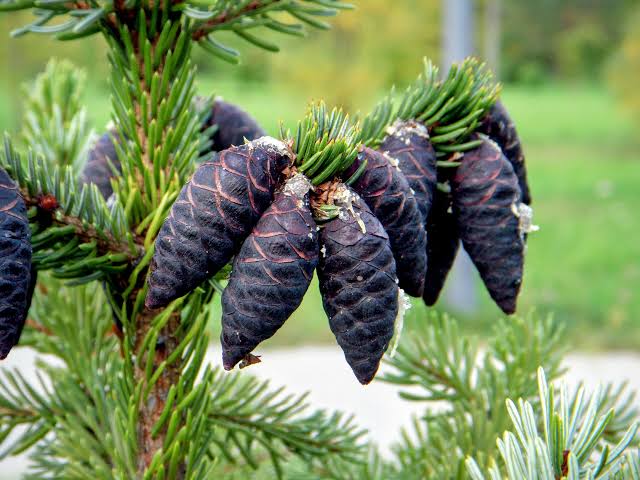
Black Spruce also referred to as Picea mariana, the black spruce is a slow-growing, small upright evergreen coniferous tree (rarely a shrub), having a straight trunk with little taper, a scruffy habit, and a narrow, pointed crown of short, compact, drooping branches with upturned tips. The bark is thin, scaly, and grayish brown. The leaves are needle-like, stiff, four-sided, dark bluish green on the upper sides, paler glaucous green below.
In its native range, the tree averages 5–15 m (15–50 ft) tall with a trunk 15–50 cm (6–20 in) diameter at maturity, though occasional specimens can reach 30 m (98 ft) tall and 60 cm (24 in) diameter. The range of the black spruce extends into northern parts of the United States: in Alaska, the Great Lakes region, and the upper Northeast.
Characteristics
- Native Area: United States.
- Height: 15-50 ft tall
- Bark: Thin and scaly, flaking off in small circular plates
- Leaves: Dark bluish green on the upper sides, paler glaucous green below.
- Cones: The cones are the smallest of all of the spruces
- Needle: slightly curved, pale green needles that are roughly ½–¾” in length
- Crown: pyramidal to conical crown
- Sunlight: Full sun
7. Dwarf Alberta Spruce

Dwarf Alberta spruce is a cultivar of the white spruce (Pica glauca). It is a dense multi-stemmed evergreen shrub with a distinctive and refined pyramidal form. It lends an extremely fine and delicate texture to the landscape composition which can make it a great accent feature on this basis alone.
Dwarf Alberta Spruce will grow to be about 10 feet tall at maturity, with a spread of 5 feet. It tends to fill out right to the ground and therefore doesn’t necessarily require facer plants in front, and is suitable for planting under power lines. It grows at a slow rate, and under ideal conditions can be expected to live for 50 years or more.
Dwarf Alberta White Spruce does best in a cool environment. Cold winters, cool summers, and good air circulation are the optimum setting. The plant will not perform at its best in areas of high heat and humidity. It prefers moist loam or alluvial soils in the full sun. It is tolerant of wet sites, wind, heat, cold, drought, and partial shade.
Characteristics
- Native Area: Alberta, Canada
- Height: 10–13 feet
- Leaves: Green foliage which emerges light green in spring
- Crown: pyramidal to conical crown
- Sunlight: Full sun
Also Read: Different Types of Weeping Trees
8. Sitka Spruce
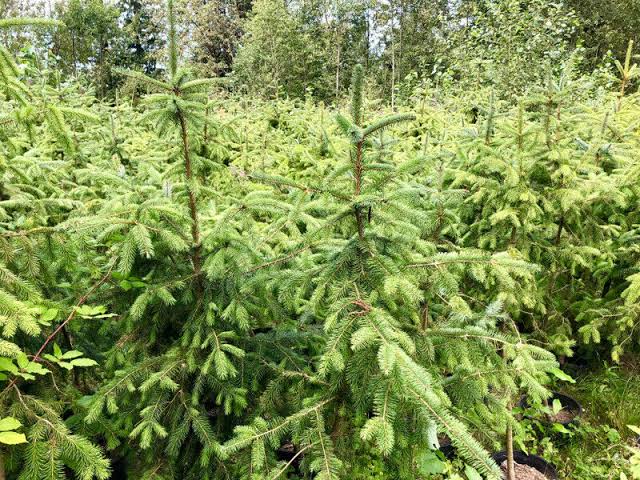
The Sitka spruce, Picea sitchensis, is a large, coniferous, evergreen tree growing to almost 100 m (330 ft) tall, with a trunk diameter at breast height that can exceed 5 m (16 ft). It is by far the largest species of spruce and the fifth-largest conifer in the world (behind giant sequoia, coast redwood, kauri, and western red cedar.
The bark is thin and scaly, flaking off in small, circular plates. The crown is broad conic in young trees, becoming cylindrical in older trees. The shoots are very pale buff-brown, almost white, and glabrous (hairless), but with prominent pulvini. The leaves are stiff, sharp, and needle-like, 15–25 mm long, flattened in cross-section, dark glaucous blue-green above with two or three thin lines of stomata, and blue-white below with two dense bands of stomata.
Characteristics
- Native Area: Western coast of Canada and the US
- Height: 330 ft tall
- Bark: The bark is thin and scaly, flaking off in small, circular plates
- Leaves: Dark glaucous blue-green above with two or three thin lines of stomata, and blue-white below
- Cones: The cones are pendulous, slender cylindrical
- Crown: pyramidal to conical crown
- Sunlight: Full sun
9. Red Spruce

Picea rubens, commonly known as red spruce is a perennial, shade-tolerant, that under optimal conditions grows to between 59–131 ft tall with a trunk diameter of about 60 cm (24 in), though exceptional specimens can reach 151 ft tall and 100 cm (39 inches) in diameter. This species is also known as yellow spruce, West Virginia spruce, eastern spruce, and he-balsam.
Red spruce has a narrow conical crown. The leaves are needle-like, yellow-green, 12–15 mm long, four-sided, curved, with a sharp point, and extend from all sides of the twig. The bark is gray-brown on the surface and red-brown on the inside, thin, and scaly. The wood is light, soft, has narrow rings, and has a slight red tinge.
Characteristics
- Native Area: Eastern North America, ranging from eastern Quebec and Nova Scotia.
- Height: 59–131 ft tall
- Bark: The bark is gray-brown on the surface and red-brown on the inside, thin, and scaly
- Leaves: The leavesare needle-like, yellow-green
- Cones: The cones are cylindrical, with a glossy red-brown color and stiff scales. The cones hang down from branches.
- Crown: pyramidal to conical crown
- Sunlight: Full sun
10. Bird’s Nest Spruce

Bird’s Nest spruce, Picea abies ‘Nidiformis’ is a slow-growing dwarf cultivar of Norway spruce. This cultivar has a dense, rounded, spreading growth habit with mostly horizontal branches. It forms a slight dip in the center of its flat top, giving it the appearance of a bird nest. Although it typically grows to 1-2 feet tall and 3-4 feet wide during the first 10 years, it can mature to up to 8 feet tall and 10-12 feet wide.
The shrub has fairly light yellowish green needles that deepen as they age to a grayish-green. They provide visual interest to the landscape year-round, as well as shelter for wildlife. The bird’s nest shrub is a slow grower and can take around 10 years to reach its mature size. It can be planted in the spring or the fall.
Characteristics
- Native Area: Northern and central Europe
- Height: 2–4 feet (can achieve 8 feet over 30 years)
- Bark: Thin and scaly, flaking off in small circular plates
- Crown: pyramidal to conical crown
- Sunlight: Full sun
11. Engelmann Spruce

Picea engelmannii also referred to as Engelmann spruce, mountain spruce or silver spruce is a medium-sized to large evergreen tree growing to 60-100 feet tall, exceptionally to 150 feet tall, and with a trunk diameter of up to 4.5 feet. The bark is thin and scaly; flaking off in small circular plates. The crown is narrow conic in young trees, becoming cylindrical in older trees.
The shoots are buff-brown to orange-brown, usually densely pubescent, and with prominent pulvini. The leaves are needle-like, 15–30 mm long, rhombic in cross-section, glaucous blue-green above with several thin lines of stomata, and blue-white below with two broad bands of stomata.
Characteristics
- Native Area: native to western North America ( central British Columbia and southwest Alberta)
- Height: 60-100 feet tall
- Bark: The bark is thin and scaly; flaking off in small circular plates
- Leaves: Needle-like
- Cones: The cones are pendulous, slender cylindrical
- Crown: pyramidal to conical crown
- Sunlight: Full sun
Also Read: Different Types of Birch Trees
12. Japanese Bush Spruce

Picea maximowiczii, the Japanese bush spruce, is a species of conifer in the pine family native to Japan. It lends an extremely fine and delicate texture to the landscape composition which can make it a great accent feature on this basis alone.
Leaves are leathery, linear, and quadrangular in cross-section, measuring 0.4 to 0.8 inch (10 – 20 mm) long and circa 0.04 inch (1 mm) across, with acute apices, deep green color, and a stomatal groove on each surface. Bark bright orange-brown, smooth then flaking in young trees, becoming grey-brown, rough, scaly and fissured in older trees.
Characteristic
- Native Area: Japan
- Height: 20-80 feet tall
- Bark: The bark is thin and scaly; flaking off in small circular plates
- Leaves: Needle-like
- Cones: The cones are pendulous, slender cylindrical
- Crown: pyramidal to conical crown
- Sunlight: Full sun
13. Dragon Spruce

Picea asperata, dragon spruce is a medium-sized evergreen tree growing to 25–40 m tall, and with a trunk diameter of up to 1.5 m. The shoots are orange-brown, with scattered pubescence. The leaves are needle-like, 1–2.5 cm long, rhombic in cross-section, greyish-green to bluish-green with .conspicuous stomatal lines. The cones are cylindric-conic, 6–15 cm long and 2–3 cm broad, maturing pale brown 5–7 months after pollination, and have stiff, rounded to bluntly pointed scales.
Characteristics
- Native Area: Native to western China, eastern Qinghai and southern Gansu
- Height: 25–40 m tall
- Bark: The bark is thin and scaly; flaking off in small circular plates
- Leaves: The leavesare needle-like
- Cones: The cones are cylindrical and pendulous
- Crown: pyramidal to conical crown
- Sunlight: Full sun
14. Sakhalin Spruce
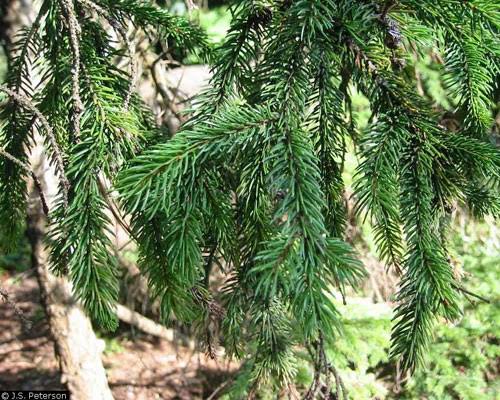
Picea glehnii, the Sakhalin spruce or Glehn’s spruce, is an evergreen coniferous species of tree that grows to mature heights of 100 feet (30 m); with a trunk up to 40 inches (100 cm) in diameter, measured at breast height. The crown of a mature tree is pyramidal to conical, presenting long, narrow branches which spread short and horizontally.
Old trees’ bark is scaly and placoid and is colored in chocolate brown (this is the feature that distinguishes this species from others). Young sprouts are usually orange or wine red haired in grooves and on stalk. The tree’s needles are about 10 millimeters long. They are four-sided and a bit curved, mature trees have blunt needles, while young ones have pointed bluish-green ones. When a needle is rubbed, it smells harsh.
Characteristics
- Native Area: Japan
- Height: 60-100 ft
- Bark: Bark is gray-brown, fissured and peeling off in scales
- Leaves: Cylindrical shape, and are peduncular with slender stalk
- Cones: The cones are cylindrical and pendulous
- Crown: pyramidal to conical crown
- Sunlight: Full sun
Also Read: Trees With Beautiful Fall Color
15. Brewer Spruce
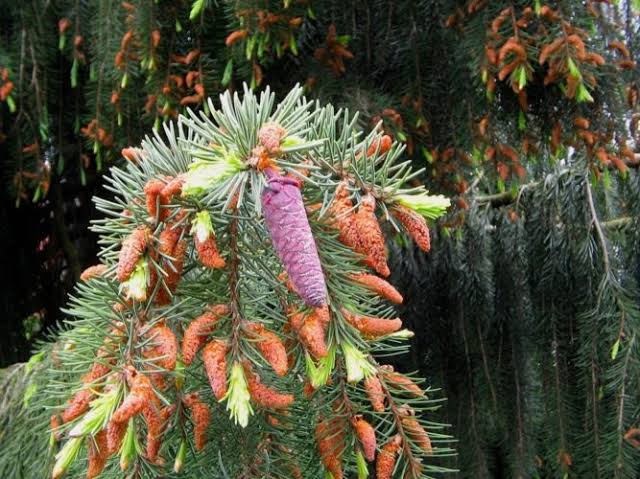
Picea breweriana, known as Brewer spruce, Brewer’s weeping spruce, or weeping spruce is a large evergreen coniferous tree growing to 20–40 m tall with a trunk diameter of up to 4 feet. The bark is thin and scaly, and purple-gray in color. The leaves are borne singly on the pulvini, and are needle-like, 15–20 mm long, flattened in cross-section, glossy dark green above, and with two bands of white stomata below.
The crown is very distinct, distinguished by level branches with vertically pendulous branchlets, each branch forming a ‘curtain’ of foliage. The pendulous foliage only develops when the tree grows to about 1.5–2 m tall. The shoots are orange-brown, with dense short pubescence about 0.2 mm long and very rough with pulvini. Brewer spruce grows very slowly, typically less than 20 cm (8 in) per year.
Characteristics
- Native Area: Native to western North America
- Height: 20-40
- Bark: The bark is thin and scaly, and purple-gray in color.
- Leaves: Glossy dark green
- Cones: The cones are cylindrical and pendulous
- Crown: pyramidal to conical crown
- Sunlight: Full sun
16. Purple Cone Spruce
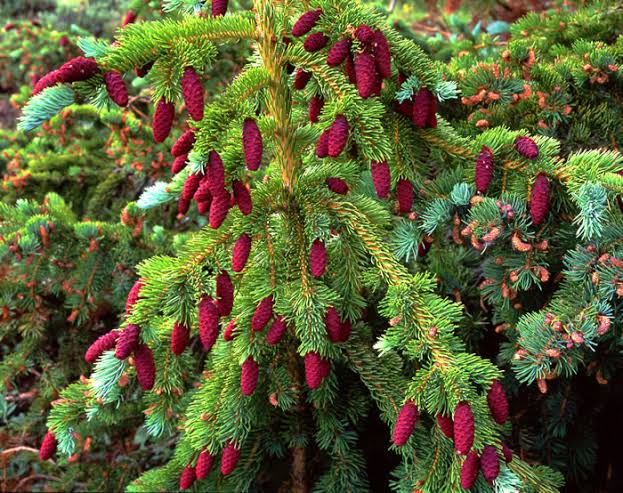
Picea purpurea, also known as purple cone spruce and purple-coned spruce is an evergreen coniferous species of tree that grows to mature heights of 165 feet (50 m) tall; with a trunk up to 40 inches (100 cm) in diameter, measured at breast height; and a pyramidal crown.
Leaves (needles) spread radially about the branchlet, or closely appressed forward on upper sides, spreading on lower side. Individual needles are straight or slightly curved and flattened-rhombic in cross section. They measure 0.28 to 0.48 inch long and 0.06 to 0.72 inch broad, with 4 to 6 stomatal lines along lower surfaces, and variable apices.
Characteristics
- Native Area: China
- Height: 20-50 m
- Bark: The bark is thin and scaly, and dark-gray in color.
- Leaves: Glossy dark green
- Cones: The cones are cylindrical and pendulous
- Crown: pyramidal to conical crown
- Sunlight: Full sun
17. Spruce Pine

Spruce pine is an evergreen coniferous species of tree that grows to mature heights of 100 feet (30 m) with a straight, but is often bent and twisted trunk up to 40 inches (100 cm) in diameter, measured at breast height, and a pyramidal to rounded crown.
Leaves (needles) grow in bundles of 2 per fascicle, spreading to ascending from the point of origin, and persisting 2 to 3 years on the tree. The straight, slightly twisted needles measure 1.6 to 3.2 inches (4 – 8 cm) long and 0.028 to 0.048 inch wide are colored dark green with lines of stomata all surfaces. Needles margins are finely serrulate, with an acute apex.
Bark on mature trees is gray, fissured and cross-checked into elongate, irregular, scaly plates, lacking resin pockets. It resembles red oak bark, and is unlike any other pine in the region. On younger trees and branches, the bark is smooth and gray.
Characteristics
- Native Area: North America
- Height: 50-100 feet
- Bark: Bark on mature trees is gray, fissured and cross-checked into elongate, irregular, scaly plates
- Leaves: Glossy dark green
- Cones: The cones are cylindrical and pendulous
- Crown: pyramidal to conical crown
- Sunlight: Full sun
Further References
- Facts About Spruce trees: https://en.m.wikipedia.org/wiki/Spruce
- Types of Spruce Trees: https://www.thespruce.com/twelve-spruce-trees-and-shrubs-3269669
- Spruce Trees: https://www.britannica.com/plant/spruce
- Types of Spruce Trees: https://conifersociety.org/conifers/articles/10-types-of-spruce-trees-everyone-should-know/